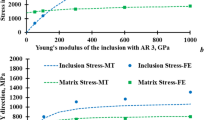Abstract
It is often suggested in literature to use change in the effective elastic properties (stiffness loss) as an indicator of reduction of strength due to defects such as cracks and pores. We argue that the key parameter is not the reduction of the average (over the specimen) stiffness but its local minimal values caused by formation of defect clusters. These defect clusters can be identified by the emergence of spatial gradients of elastic stiffness on a smaller scale. A convenient tool of detecting these gradients is provided by the elasticity-conductivity connection: the electric conductance gradient is usually easier to measure than the stiffness gradient. This concept is supported by computational and experimental results reported in two accompanying papers published in the present issue (by Sevostianov et al and Caiulo and Kachanov).
Similar content being viewed by others
References
Bristow D. (1960) Microcracks and the static and dynamic elastic constants of annealed heavily cold-worked metals. British Journal of Applied Physics, 11: 81–85
Caiulo, A. and Kachanov, M (2010) On absence of quantitative correlations between strength and stiffness in microcracking materials. International Journal of Fracture, DOI 10.1007/s10704-010-9486-5 (This issue).
Cotterell B., Rice J.R. (1980) Slightly curved or kinked cracks. International Journal of Fracture 16(2): 155–169
Kachanov, L. M. (1958) Rupture time under creep conditions, Izvestija Academii Nauk SSSR, 8: 26-31 (Reprinted in International Journal of Fracture, 97, 11-18).
Kachanov M. (1994) On the concept of damage in creep and in the brittle-elastic range. International Journal of Damage Mechanics 3: 329–337
Krajcinovic D. (1989) Damage mechanics. Mechanics of Materials 8: 117–197
Kushch V.I., Shmegera S.V., Sevostianov I. (2009) SIF statistics in micro cracked solids: effect of crack density, orientation and clustering. International Journal of Engineering Science, 47: 192–208
Kushch V.I., Sevostianov I., Mishnaevsky L. (2009) Effect of crack orientation statistics on effective stiffness of mircocracked solid. International Journal of Solids and Structures 46: 1574–1588
Maugin, G.R. (1992). The Thermomechanics of Plasticity and Fracture. Cambridge University Press.
Murakami Y. (ed.) (1987) Stress Intensity Factors Handbook. Pergamon Press.
O’Brien T.K., Reifsnider K.L. (1977) Fatigue damage: Stiffness/strength comparison for composite materials. Journal of Testing and Evaluation, 5: 384–393
Reifsnider, K. and Stinchcomb, W. (1983) Stiffness change as a fatigue damage parameter for composite laminates. In: Advances in Aerospace Structures, Materials and Dynamics, ASME (Ed. U.Yuceoglu et al), 1-6.
Rice, J. R. (1975) Continuum mechanics and thermodynamics of plasticity in relation to microscale deformation mechanisms. In: Constitutive Equations in Plasticity (Ed. A. Argon), MIT Press, 171-190.
Sevostianov I., Kachanov M. (2002) Explicit cross-property correlations for anisotropic two-phase composite materials. Journal of the Mechanics and Physics of Solids 50: 253–282
Sevostianov, I. and Kachanov, M. (2008) Connections between elastic and conductive properties of heterogeneous materials. In: Advances in Applied Mechanics (Ed. by Van der Giessen), vol. 42, 69-252.
Sevostianov I., Kushch V.I. (2009) Effect of pore clusters on the statistics of peak stress and overall properties of porous material. International Journal of Solids and Structures 46: 4419–4429
Sevostianov, I., Zagrai, A., Kruse, W.A., Hardee, H.C. (2010) Connection between strength reduction, electric resistance and electro-mechanical impedance in materials with fatigue damage, International Journal of Fracture, DOI 10.1007/s10704-010-9487-4 (This issue).
Tsukrov I., Kachanov M. (1997) Stress concentrations and microfracturing patterns in a brittle-elastic solid with interacting pores of diverse shapes. International Journal of Solids and Structures 34(22): 2887–2904
Author information
Authors and Affiliations
Corresponding author
Rights and permissions
About this article
Cite this article
Sevostianov, I., Kachanov, M. Local Minima and Gradients of Stiffness and Conductivity as Indicators of Strength Reduction of Brittle-Elastic Materials. Int J Fract 164, 147–154 (2010). https://doi.org/10.1007/s10704-010-9485-6
Published:
Issue Date:
DOI: https://doi.org/10.1007/s10704-010-9485-6




